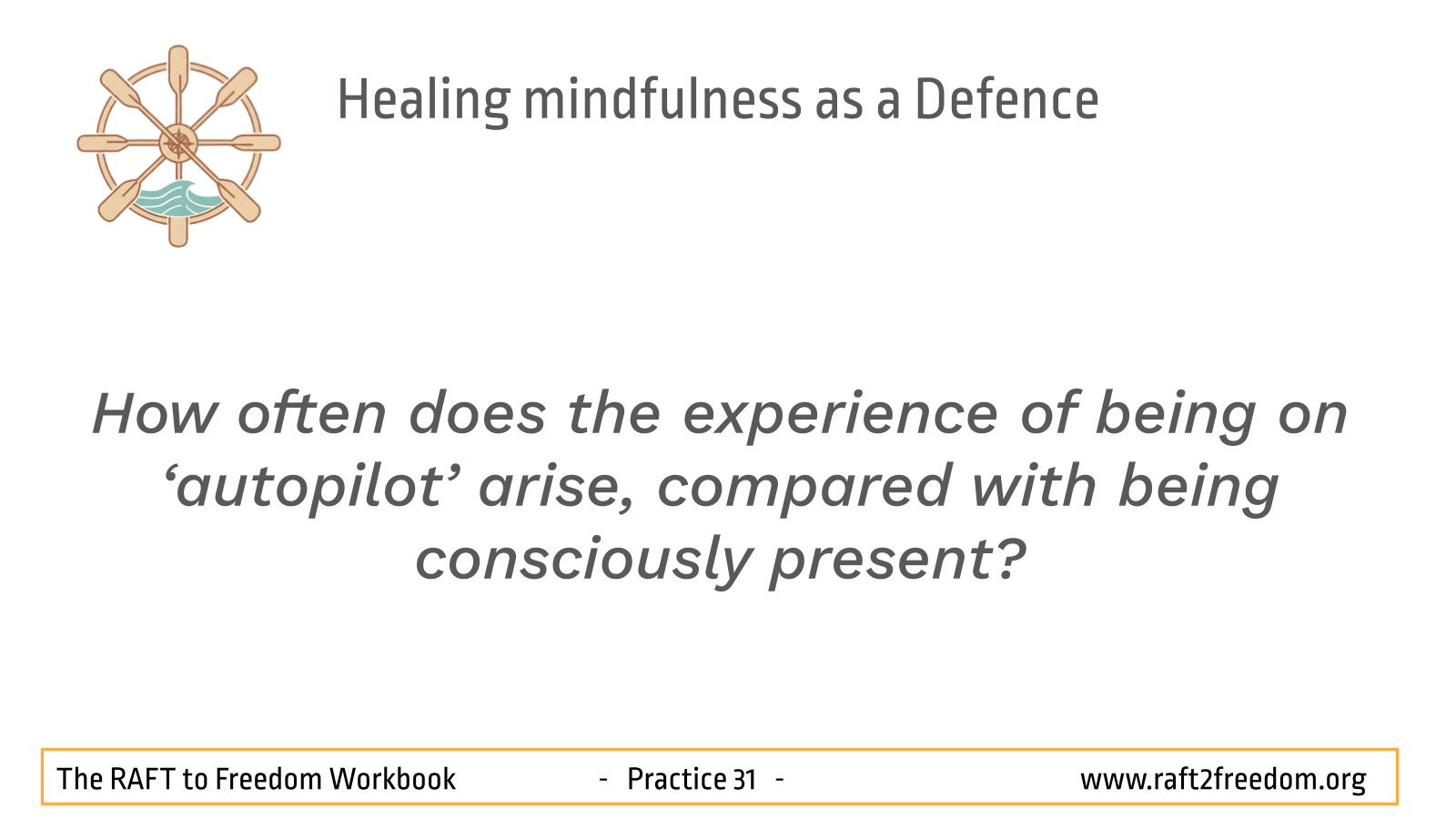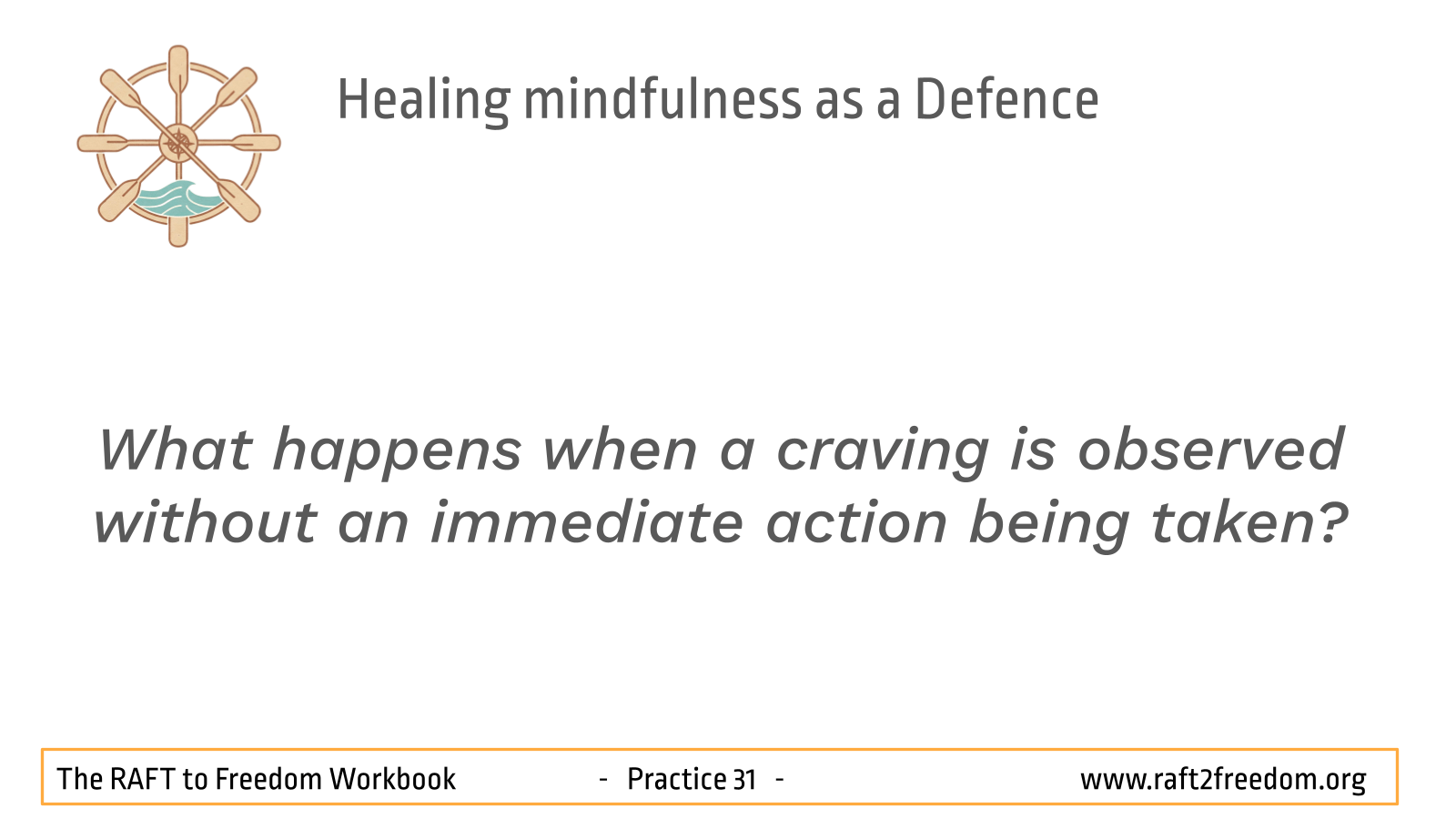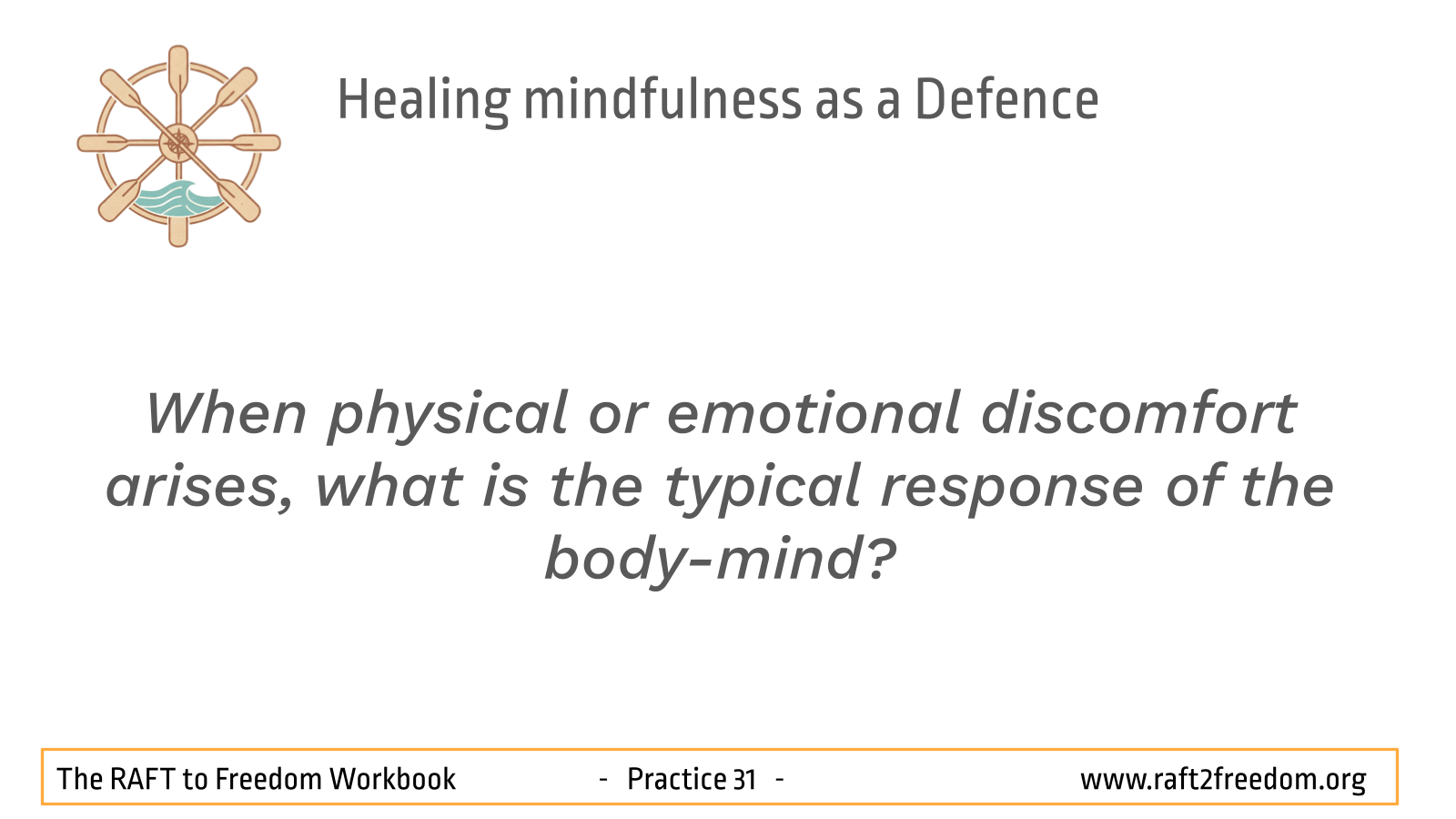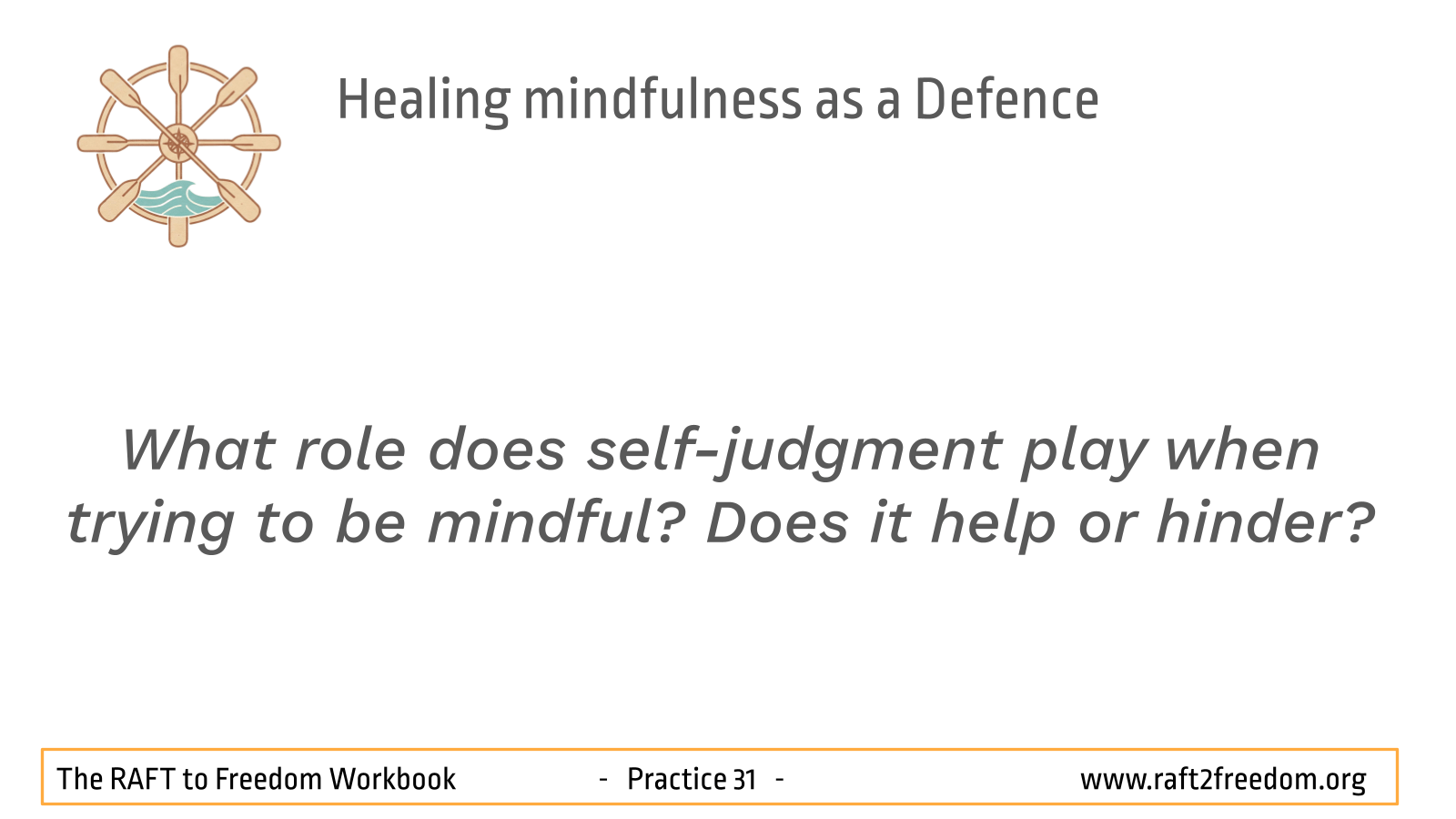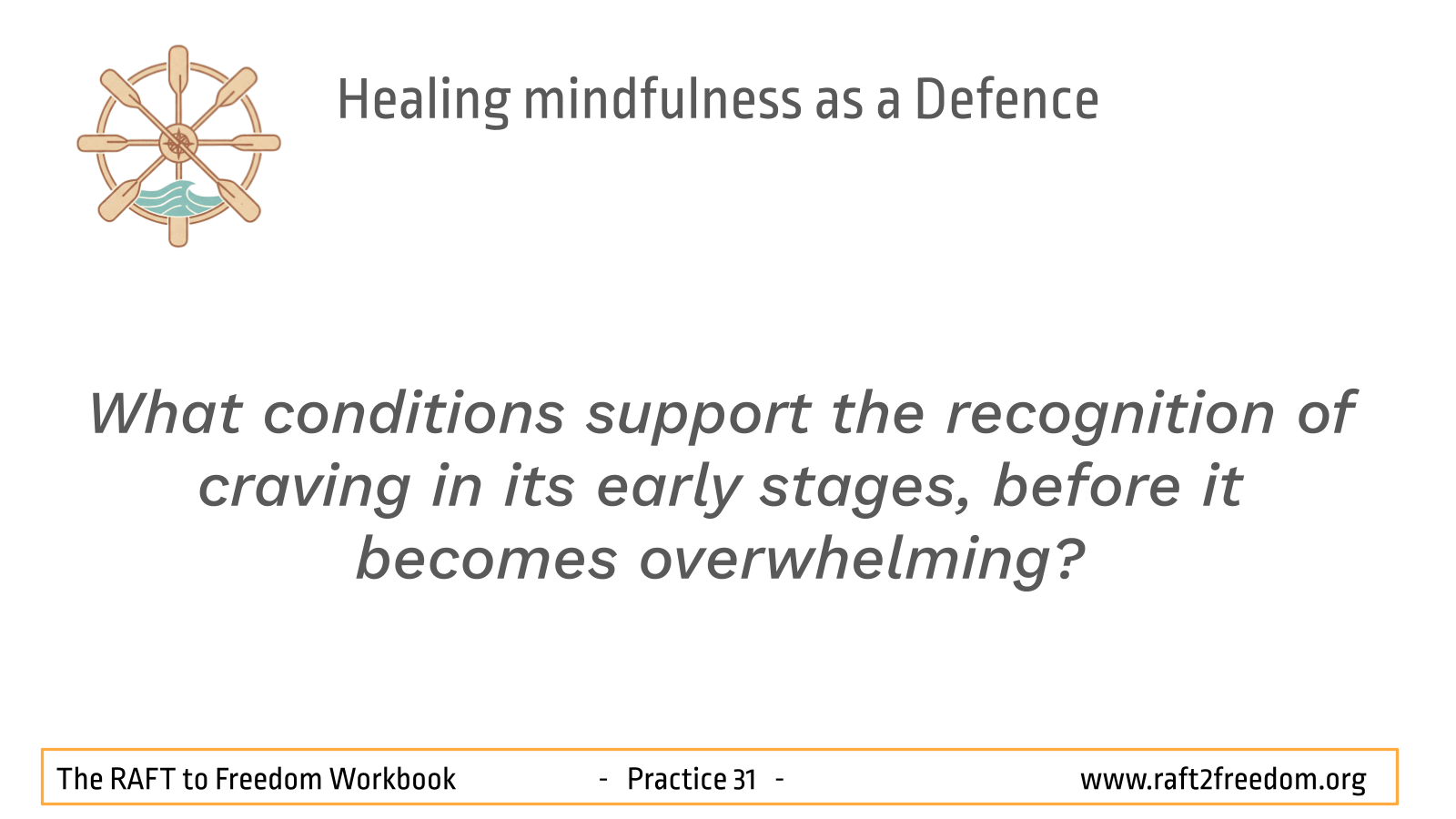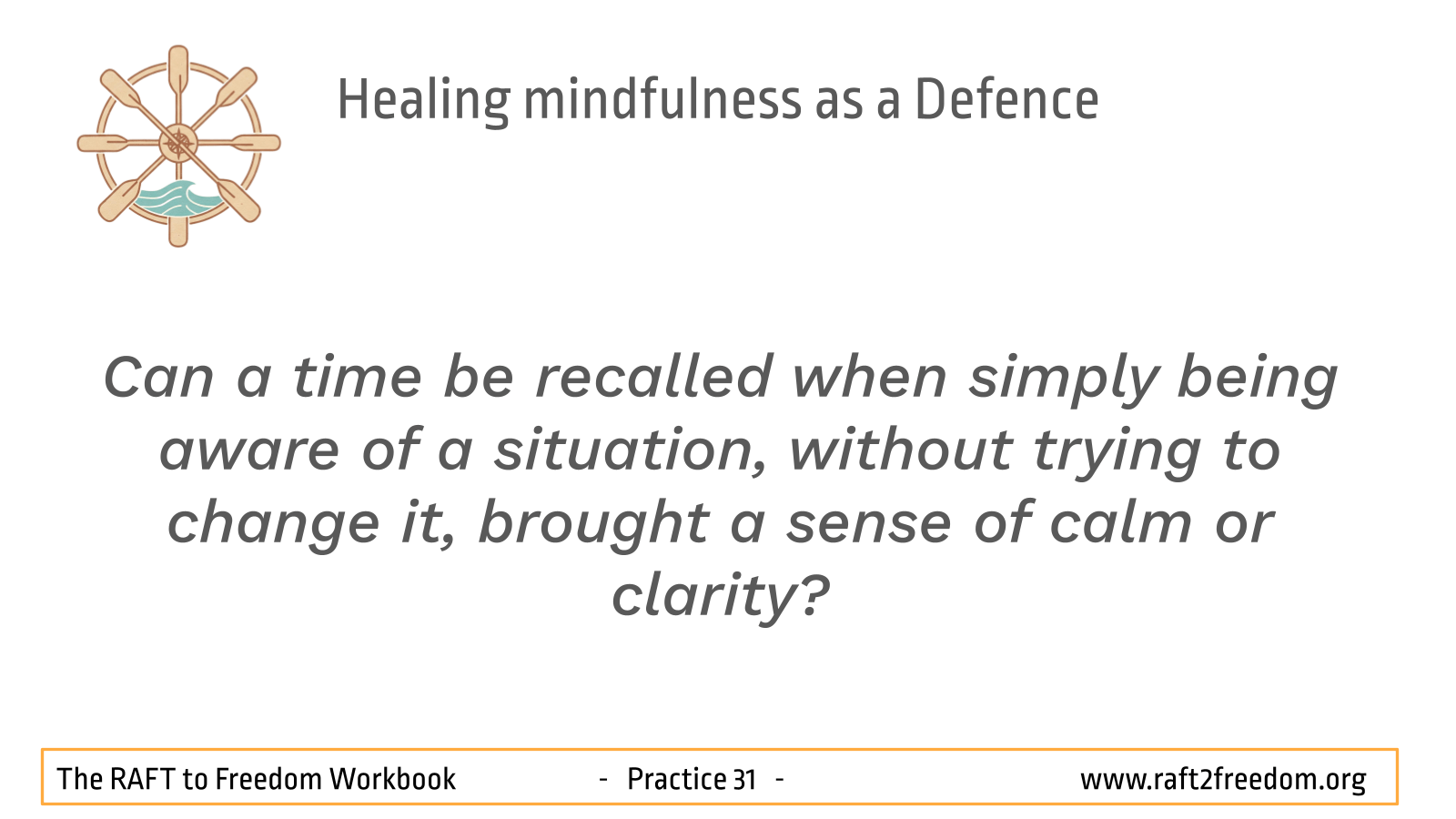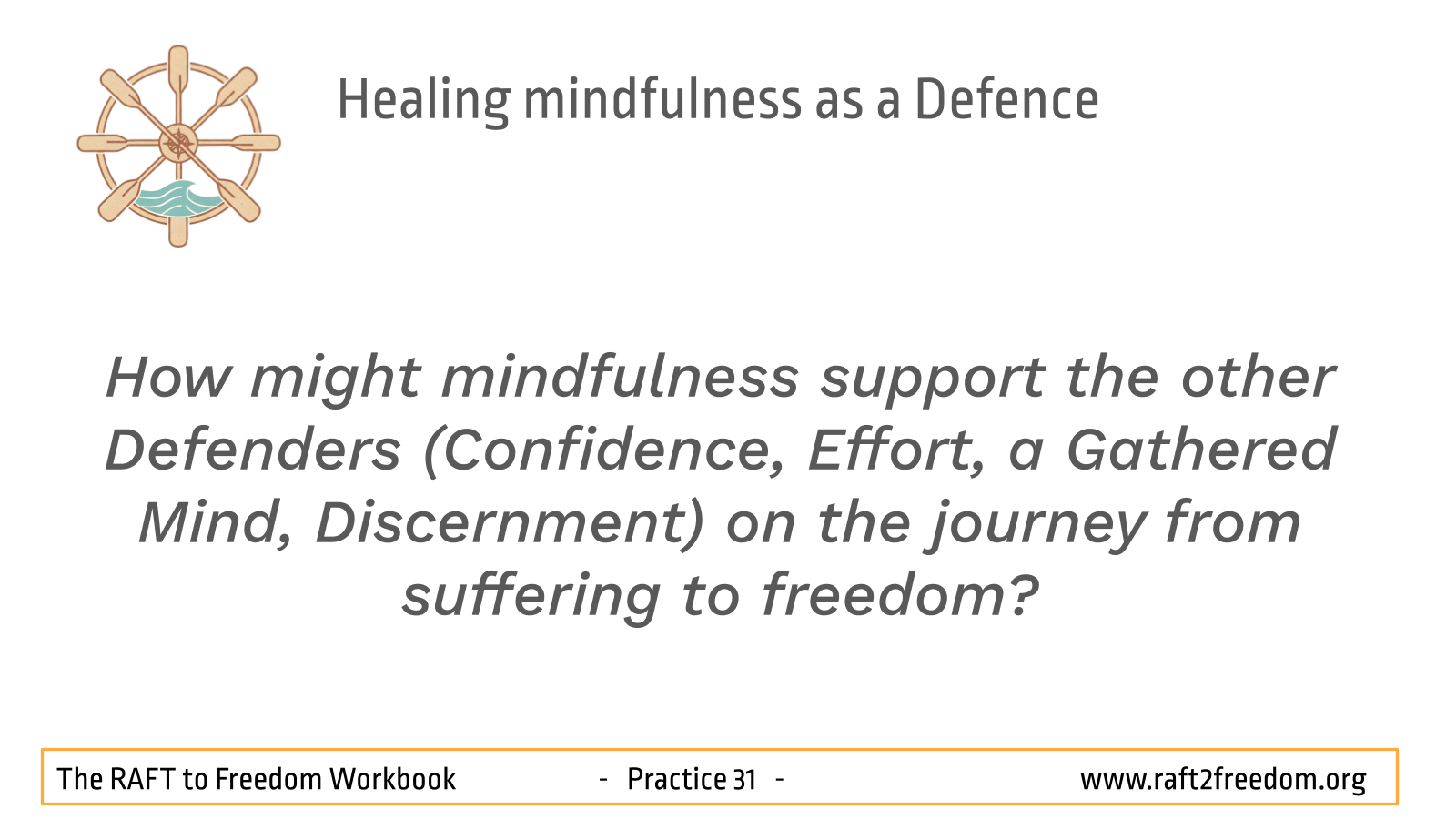Healing mindfulness as a defence
A mind guarded by mindfulness is freed from the bonds of Māra.
Gotama (the Buddha)
Each time you return to the present, you are choosing freedom over habit.
Jack Kornfield

Episode 31 – Healing Mindfulness as a Defence
An AI generated ‘deep dive’ into this aspect of the RAFT to Recovery
We now begin with the third of the ‘Five Defenders’ – Healing Mindfulness (sati). If Confidence provides the trust to step aboard the raft and Courageous Effort provides the energy to move forward, then Healing Mindfulness serves as the vigilant watchman. It is the attentive, clear-seeing presence that allows the raft to be steered wisely.
The Pāli word sati literally means ‘to remember’ or ‘to keep in mind’. In this practice, it is remembering to pay attention to the present-moment experience without judgment, but with wise discernment. It is a clear, alert, and non-judging awareness of what is happening now – sensations in the body, tones of feeling, movements of thought, and changes in the world around us.
Healing Mindfulness is the direct antidote to the mindlessness, dissociation, and distraction where patterns of escape and self-sabotage thrive. It helps us meet pain without avoidance, pleasure without clinging, and impulses without automatically acting on them. By cultivating Healing Mindfulness, we create a crucial pause, a space between stimulus and response where choice becomes possible. This clear seeing is the primary tool for recognising the persuasive whispers of Māra – the voice of craving, aversion and confusion – before it can take hold of the raft’s rudder.
In the context of this journey, mindfulness takes a specific form. The Secular Buddhist teacher Stephen Batchelor’s model of mindfulness clarifies that the task of abandoning harmful cravings requires what he calls ‘therapeutic mindfulness’ and we have termed this Healing Mindfulness. This form of mindfulness is particularly aligned with the second foundation of mindfulness – Mindfulness of Feeling Tone (which we explored in Chapter 27), which allows us to see, feel, and understand experience just as it is. It is the capacity that meets reactivity not with suppression or indulgence, but with calm awareness.
Placed within the ‘Five Defenders’, Healing Mindfulness stands in the middle. It is supported by ‘Confidence’ and ‘Courageous Effort’, steadied by ‘A Gathered Mind’, and clarified by ‘Discernment’. Each of the Defenders relies on the others: Confidence motivates mindfulness; Courageous Effort keeps it alive; a Gathered Mind provides stability for it to rest upon; and Discernment uses the data mindfulness provides to guide wise choice.
In our RAFT to Freedom metaphor, where there is a single captain, navigator, and crew, Healing Mindfulness is the lookout. It constantly scans the surrounding waters (external triggers), monitors the internal weather (the emotional climate), and checks the condition of the raft itself (internal states, bodily sensations, thoughts). As the vigilant watchman, Healing Mindfulness notices the subtle currents of Feeling Tone, spots the first signs of leaks (cravings), and sees approaching hazards early. This allows the inner navigator (Discernment) to plot a skillful course and the inner crew (Courageous Effort) to respond effectively, rather than the whole vessel reacting blindly. Without this protective and constant vigilance, the raft is blind; with it, the voyage becomes navigable.
How to practise Healing Mindfulness
Mindfulness is the practice of remembering – returning again and again to what is actually happening in the present moment. These practices help steady the raft amid the currents of craving, distraction, and habit. Some are formal, anchored in dedicated moments of practice; others are informal, woven through the ordinary flow of daily life.
Formal practices
- Mindfulness of breathing: Return to the present anchor. Each breath becomes a point of steadiness – the place you return to when the waves of thought, craving, or distraction rise. Every gentle return to the breath is an act of remembering: the raft is here, and you are still afloat.
- Purpose on the raft: to steady awareness and strengthen presence, even amid restless waters.
- Body scan meditation: Reconnect mind and body; ground awareness in the vessel itself. As attention moves slowly through the body, sensations are felt directly – tightness, warmth, pulsing, release. This practice restores the sense of wholeness and balance that keeps the raft stable.
- Purpose on the raft: to re-establish balance and sensitivity to early signs of strain or disconnection.
- Mindful movement
Bring awareness into motion – walking, stretching, or yoga. Notice how balance shifts, effort flows, and rhythm changes. Movement becomes a teacher of agility and responsiveness.- Purpose on the raft: to stay flexible and responsive, learning how to adjust when conditions change.
Informal practices
- Mindful check-ins: Pause briefly throughout the day to ask: “What is happening right now? What is present in the body? What thoughts are appearing? What feelings are here?”. Each check-in is a small act of navigation – a way to orient ourselves before the current carries us elsewhere.
- Purpose on the raft: to keep awareness alive in the midst of daily flow.
- Mindful routines: Bring full attention to simple actions – washing dishes, eating, showering – and notice every sensory detail. When mindfulness enters ordinary moments, even the smallest act becomes part of the path.
- Purpose on the raft: to transform autopilot living into continuous practice, making each moment part of the journey.
- Urge surfing: When a craving arises, meet it with mindful curiosity. Feel its sensations rise, crest, and fall like a wave passing beneath the raft. There is no need to act or resist; simply ride it out with awareness.
- Purpose on the raft: to strengthen confidence and trust in your ability to stay afloat when urges swell.
- Noting and labelling: Gently name what arises – “thinking,” “worrying,” “craving is here,” “sadness is felt.” This naming creates space between awareness and experience, loosening the pull of habitual reactions.
- Purpose on the raft: to cultivate clarity and distance, preventing the mind from being swept away.
- Observing Feeling Tones: Notice the immediate flavour of experience – pleasant, unpleasant, or neutral – without needing to analyse or fix it. Seeing Feeling Tones clearly reveals the undercurrents that drive craving and aversion.
- Purpose on the raft: to recognise early signs of reactivity and steer the course toward freedom.
Healing mindfulness — the protector
Together, these practices form the living discipline of Healing Mindfulness – the mindful Defender that stands watch at the gate of the heart. It notices what approaches before it enters: a thought, an emotion, a craving, a memory. It does not fight or flee, but simply recognises what is here. In this recognition, the power to choose arises. Through remembering, the raft steadies. Through awareness, the traveller learns again and again how to meet the moment – and stay free upon the water.
Self-reflections
- How often does the experience of being on ‘autopilot’ arise, compared with being consciously present?
- What happens when a craving is observed without an immediate action being taken?
- When physical or emotional discomfort arises, what is the typical response of the body-mind?
- What role does self-judgment play when trying to be mindful? Does it help or hinder?
- What conditions support the recognition of craving in its early stages, before it becomes overwhelming?
- Can a time be recalled when simply being aware of a situation, without trying to change it, brought a sense of calm or clarity?
- How might mindfulness support the other Defenders (Confidence, Effort, a Gathered Mind, Discernment) on the journey from suffering to freedom?
Journaling prompts
- Mindful moment: Choose one routine daily activity (for example, drinking a morning beverage). Commit to doing it mindfully for a few days. Journal about what is noticed – sensations, thoughts, impulses – when focused awareness is brought to it.
- Observing an urge: The next time a significant compulsion arises, try to pause and observe it mindfully for at least one minute before deciding how to respond. Afterwards, write about the physical sensations, thoughts, and intensity that were noticed. Did it change during the observation?
- Noticing judgment: Pay attention to moments of self-judgment. When the inner critic arises, simply note it – ‘judgment is present’ – without judging the judgment itself. Write about this experience – what is it like to observe the critic without engaging?
- The observer: Reflect on the idea of an ‘observing awareness’ that can notice thoughts, feelings, and sensations without being identical to them. Write about moments when this sense of being the observer has been experienced.
- Tracking ‘Feeling Tone’: For one day, notice when feelings are pleasant, unpleasant, or neutral. Journal about how awareness of these tones influenced choices and reactions.
- Mindlessness and habit: Reflect on the relationship between mindlessness and compulsive behaviours. When is the mind most likely to be on ‘autopilot,’ and how does this state contribute to harmful patterns?
- Mindfulness and the other Defenders: Reflect on a situation where mindfulness worked together with confidence, effort, A Gathered Mind, or Discernment. How did this teamwork support freedom?
Supporting Material: scientific and philosophical perspectives
For those interested in the scientific and philosophical underpinnings of Healing Mindfulness as a Defender, the following overview highlights some key connections.
- Neuroscience: Mindfulness practice is consistently linked to changes in brain structure and function. It strengthens activity in the prefrontal cortex (PFC), which supports executive functions like attention control, emotional regulation, and impulse inhibition. It helps regulate the amygdala, the brain’s alarm system, reducing reactivity to stress and emotional triggers. Practice also decreases activity in the Default Mode Network (DMN), linked to mind-wandering, rumination, and self-centred thinking. Furthermore, it enhances interoception – the awareness of internal bodily states – which helps detect cravings and aversions as they arise.
- Psychology: Mindfulness is a core component of many evidence-based therapies, including MBSR, MBCT, DBT, MBRP and ACT. It facilitates cognitive defusion (or decentering), which is the ability to see thoughts as temporary mental events rather than as commands or absolute truths. It enhances emotional regulation by creating space before reaction and improves distress tolerance by helping individuals stay present with discomfort. By enhancing awareness of internal signals, it is crucial for identifying triggers and interrupting the automatic behavioural patterns that fuel the human struggle with craving and avoidance.
- Philosophy: The emphasis on present-moment awareness resonates with phenomenological and existential traditions that prioritise direct, lived experience. The practice of non-judgmental observation aligns with Stoic ideals of seeing events objectively without adding distressing interpretations. Buddhist philosophy places Mindfulness, ‘sati’ at the heart of the path, considering it essential for seeing reality clearly (yathābhūta) and abandoning the causes of suffering. The practice encourages a ‘Radical Acceptance’ of reality as it is, which is not passive resignation but a courageous willingness to be with the truth of the present moment – the necessary foundation for wise action.
Remember to remember
Healing Mindfulness is the gatekeeper of freedom. It is the practice of remembering to return to the present moment, again and again, with kindness and clarity. As the vigilant watch on our raft, it stands guard, noticing the storms of craving and confusion as they gather on the horizon. This early awareness gives us time to prepare and respond wisely, rather than being capsized by their force.
Remember that mindfulness is not about eliminating thoughts or feelings; it is about noticing them with a kind and steady attention, neither clinging nor rejecting. Each moment of awareness weakens old patterns and strengthens freedom. Together with the other Defenders, Healing Mindfulness ensures balance: Confidence provides trust, Courageous Effort fuels persistence, A Gathered Mind brings stability, and Discernment guides the course. Healing Mindfulness weaves them all together, allowing the voyage to be guided with clarity and care.
Mindfulness isn’t difficult; we just need to remember to do it.
Sharon Salzberg
Each act of mindful awareness is a small rebellion against the tyranny of habit.
Stephen Batchelor
Sutta References
- Satipaṭṭhāna Sutta (MN 10 / DN 22) – The Foundations of Mindfulness
- Summary: This is the foundational discourse detailing the practice of mindfulness across four domains: body, feeling tones, mind states, and dhammas (mental qualities or principles). It describes sati as the ‘direct path to purification’. It provides the canonical basis for mindfulness practice and shows its vital role in noticing feeling tone, which is crucial for abandoning craving.
- Indriya-vibhaṅga Sutta (SN 48.10) – Analysis of the Faculties / Bala Sutta (AN 5.14) – The Powers
- Summary: These texts define sati as both a spiritual faculty (indriya) and a power (bala). As a faculty, it may waver, but when developed into a power, it becomes unshakable by heedlessness or forgetfulness. They explain how consistent practice matures mindfulness into a dependable strength—the very role it plays as a Defender.
- Vitakkasanthana Sutta (MN 20) – The Relaxation of Thoughts
- Summary: This sutta offers five practical strategies for addressing unwholesome or distracting thoughts, a process which requires first mindfully noticing their presence. It demonstrates mindfulness as the essential first step in recognising and interrupting harmful mental patterns that lead to suffering.
| RAFT to Freedom © 2025 by Dr Cathryn Jacob and Vince Cullen is licensed under Creative CommonsAttribution-NonCommercial-ShareAlike 4.0 International. |
